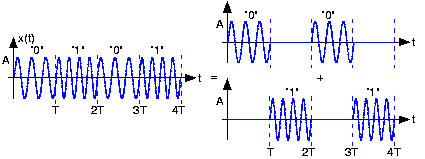| << Chapter < Page | Chapter >> Page > |
In frequency-shift keying (FSK), the bit affects the frequency of a carrier sinusoid.

The frequencies , are usually harmonically related to the bit interval. In the depicted example, and . As can be seen from the transmitted signal for our example bit stream ( [link] ), the transitions at bit interval boundaries are smoother than thoseof BPSK .

To determine the bandwidth required by this signal set, we again
consider the alternating bit stream. Think of it as two signalsadded together: The first comprised of the signal
, the zero signal,
, zero,

Each component can be thought of as a fixed-frequency sinusoid multiplied by a square wave of period that alternates between one and zero. This baseband square wave has the same Fourier spectrum as our BPSK example, but with theaddition of the constant term . This quantity's presence changes the number of Fourier series terms required for the 90% bandwidth: Now we needonly include the zero and first harmonics to achieve it. The bandwidth thus equals, with , . If the two frequencies are harmonics of the bit-interval duration, and with , the bandwidth equals . If the difference between harmonic numbers is , then the FSK bandwidth is smaller than the BPSK bandwidth. If the difference is , the bandwidths are equal and larger differences produce a transmission bandwidthlarger than that resulting from using a BPSK signal set.

Notification Switch
Would you like to follow the 'Fundamentals of electrical engineering i' conversation and receive update notifications?